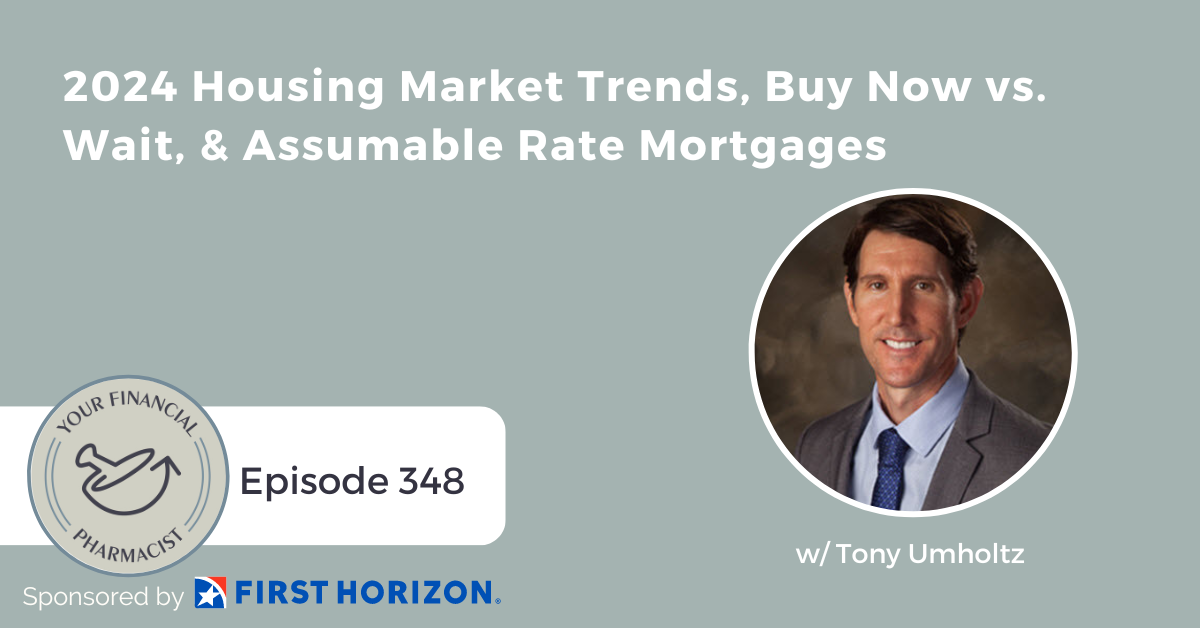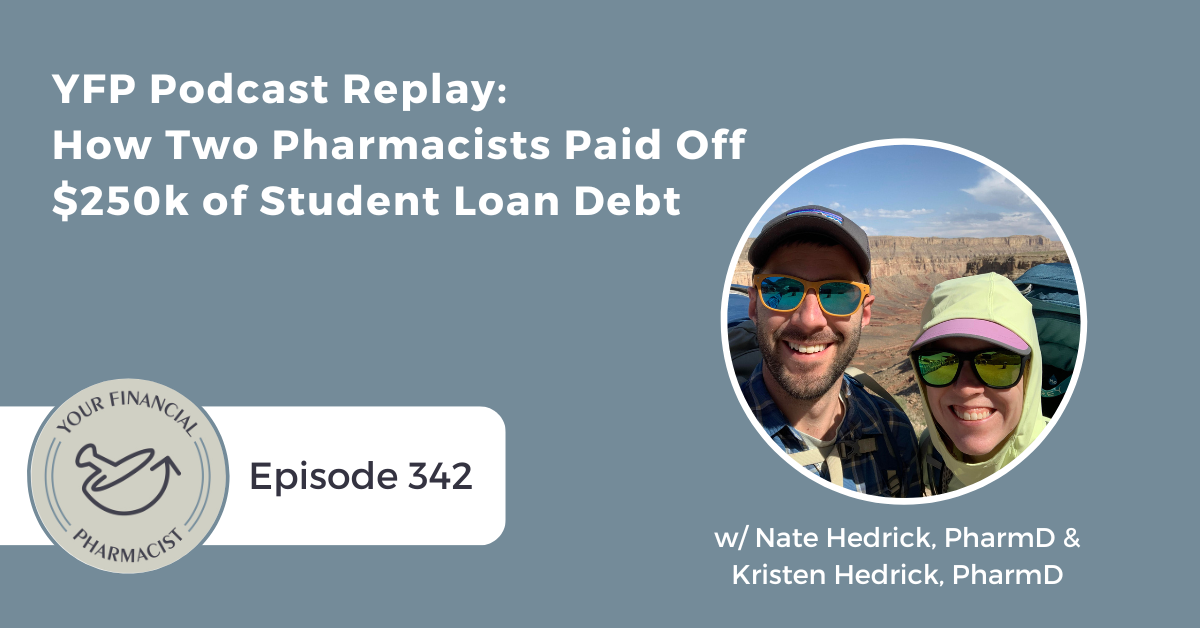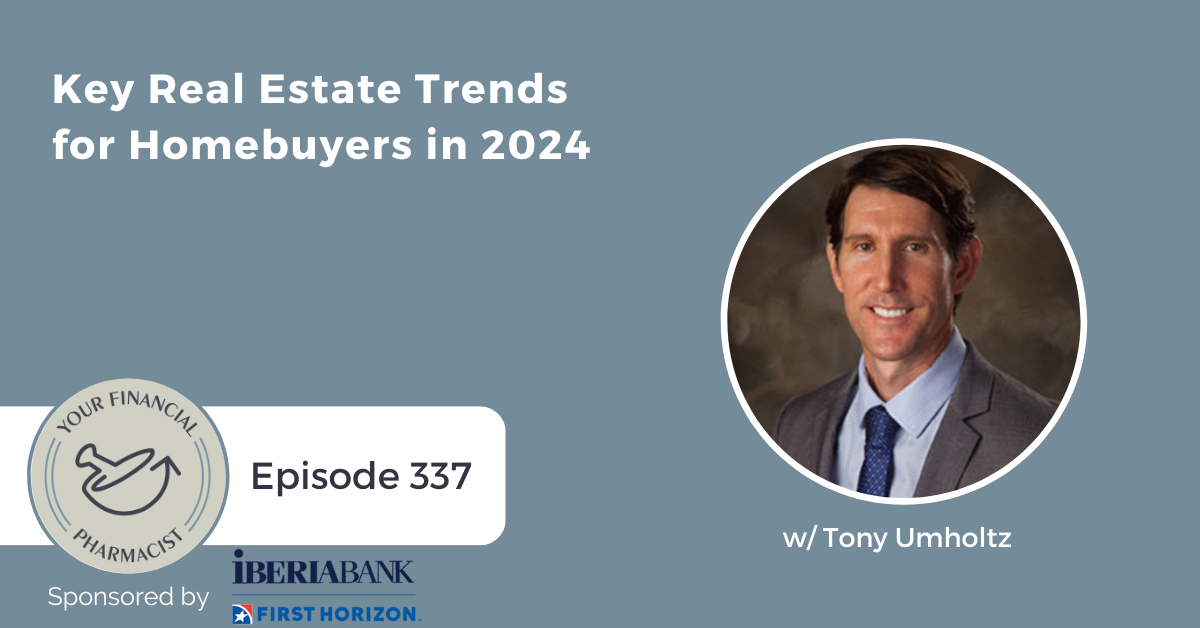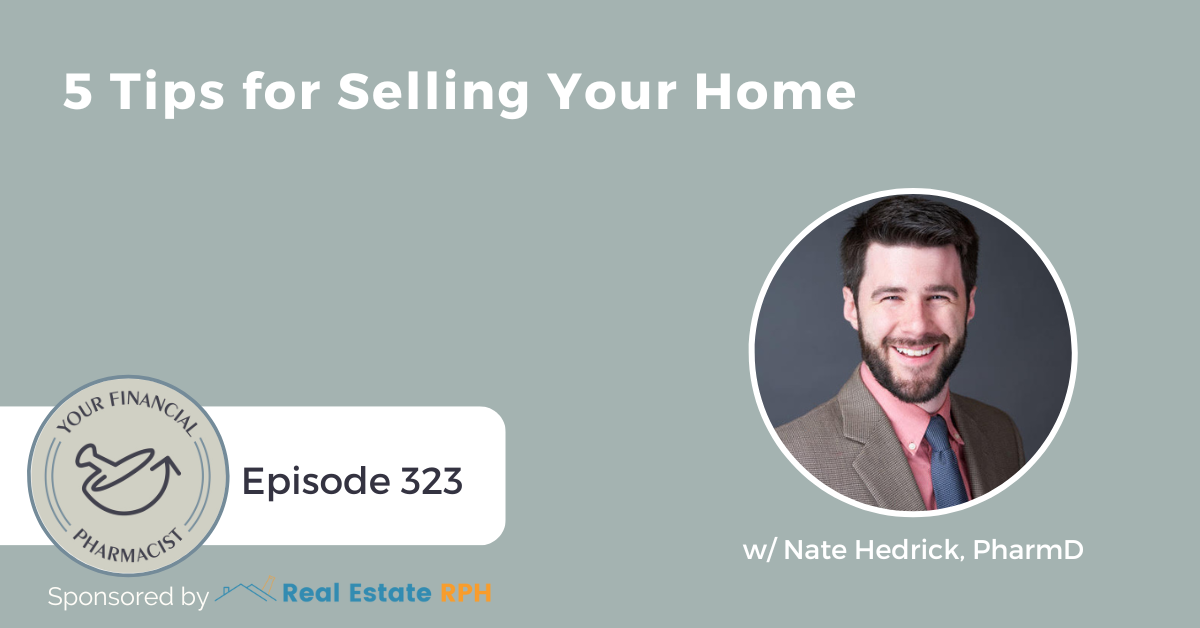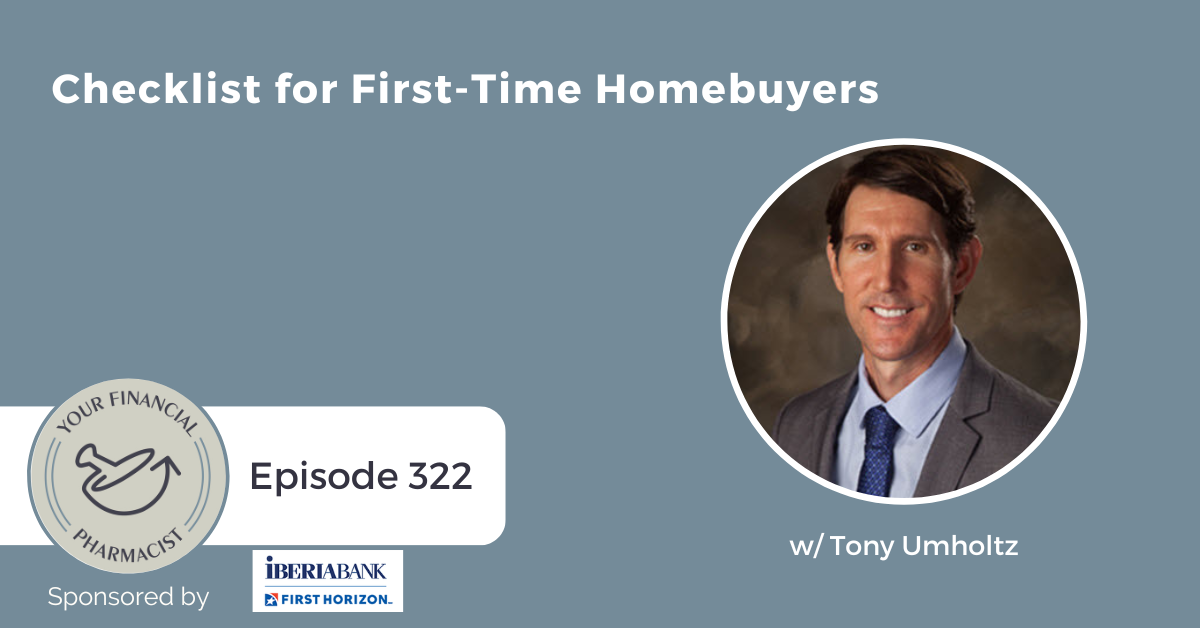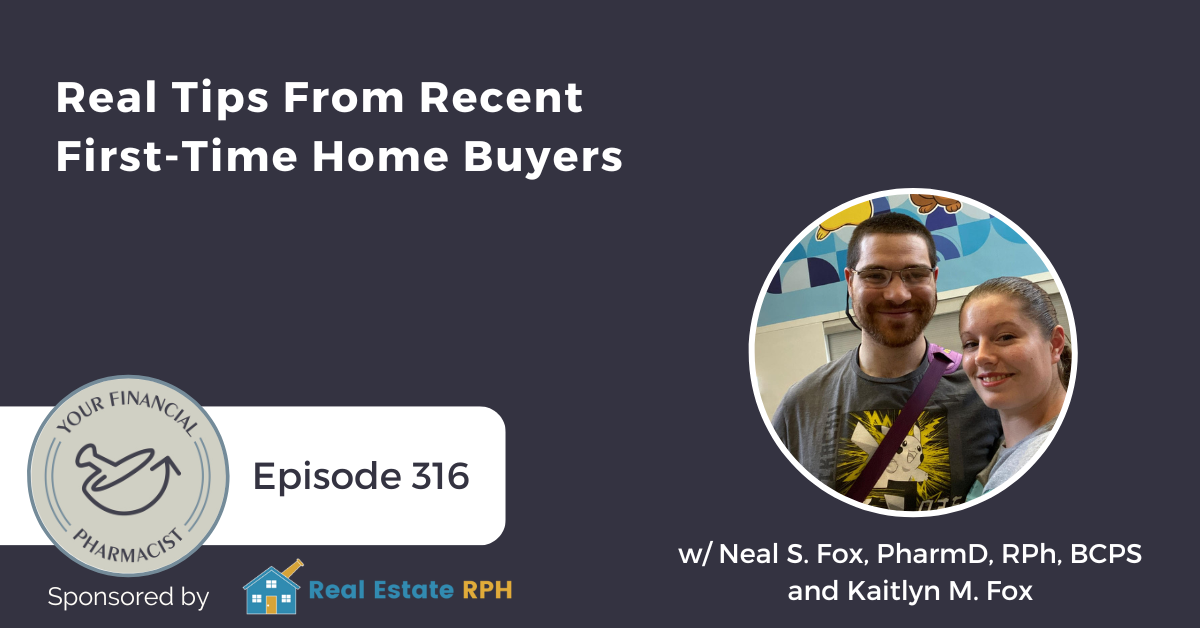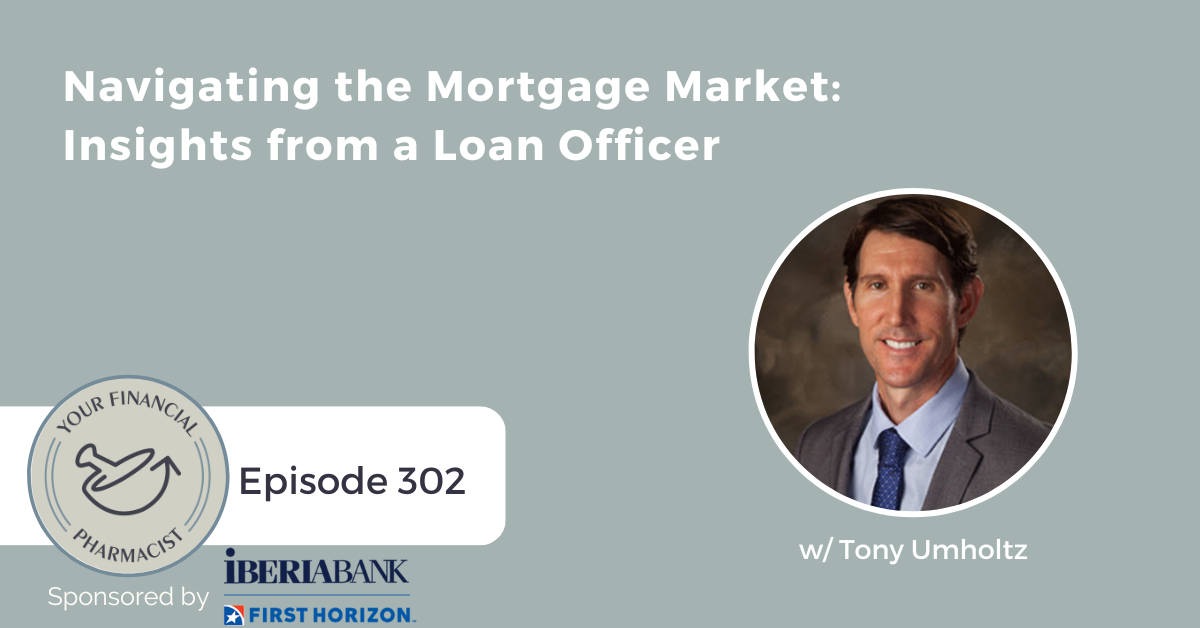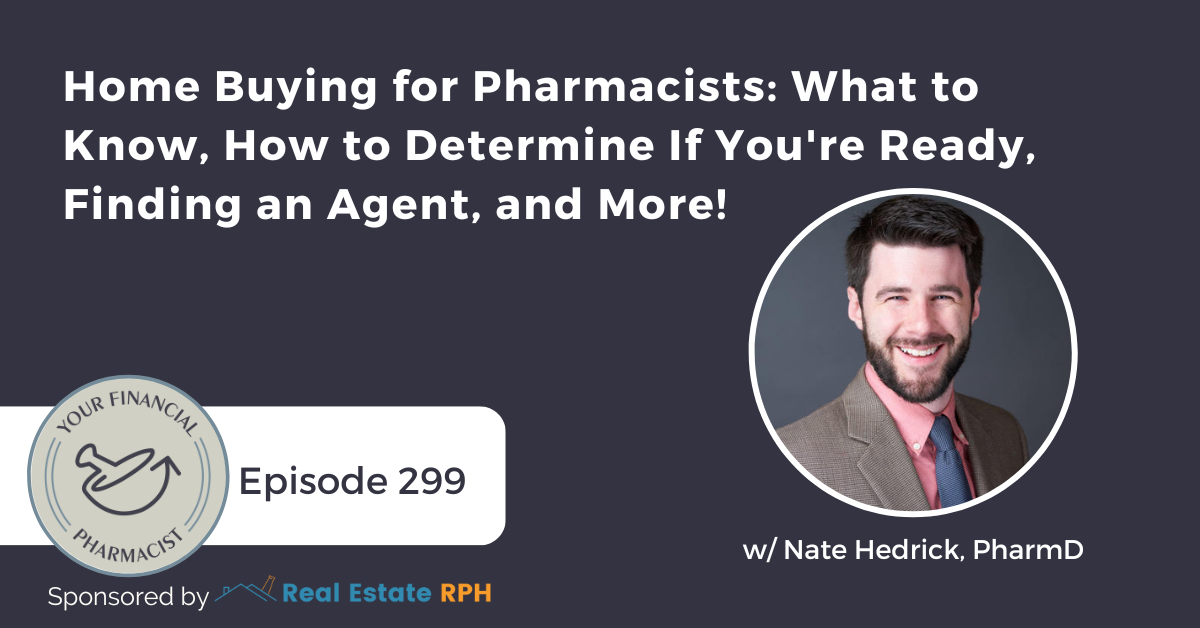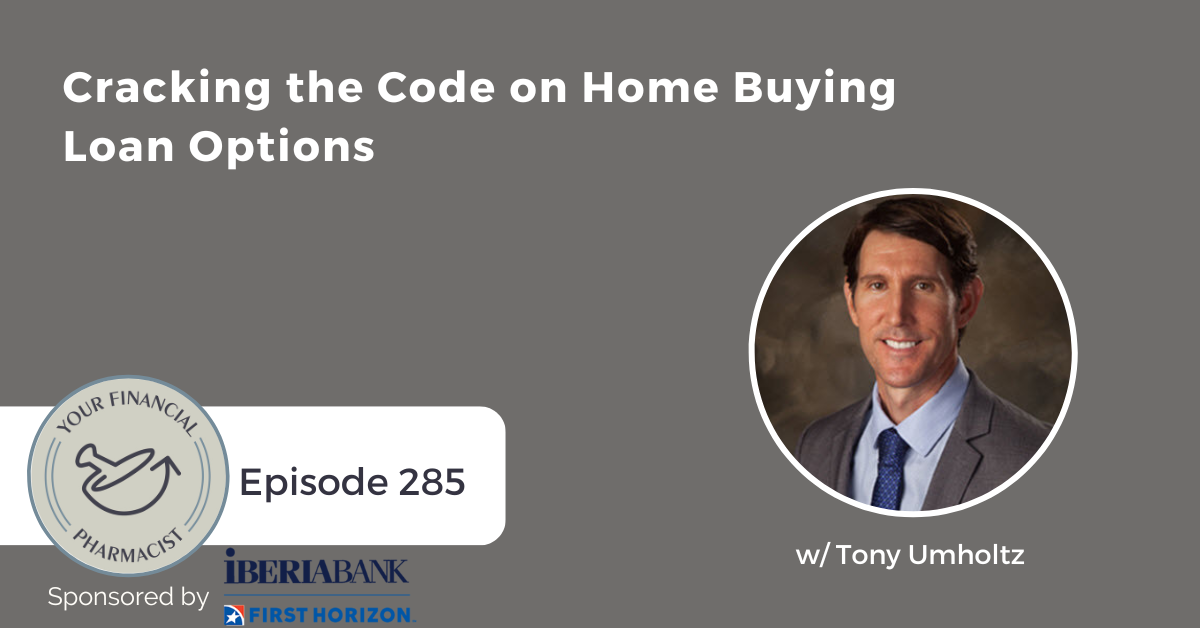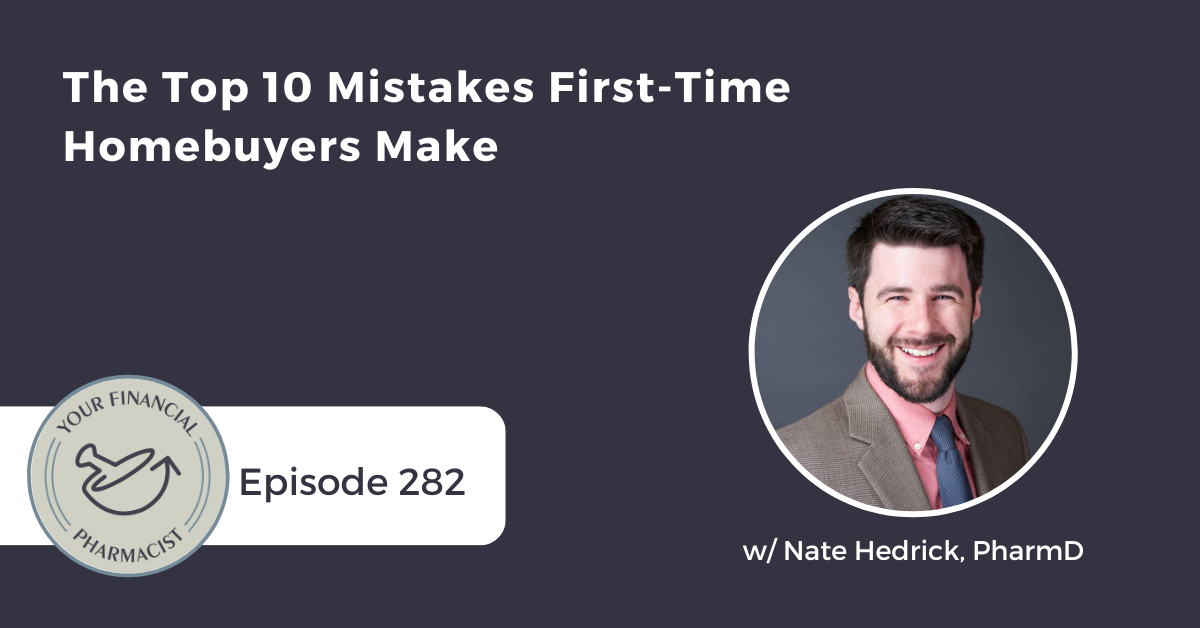Tony Umholtz of First Horizon shares insights on the real estate landscape for 2024. Sponsored by First Horizon.
Episode Summary
In this week’s podcast sponsored by First Horizon, we’re joined by Tony Umholtz, a Mortgage Loan Officer from First Horizon, to delve into the housing market updates and trends for 2024. He shares insights on current rates, supply/demand dynamics, and the impact of projected Fed Rate cuts in 2024 on the market. The episode explores the pros and cons of buying a home now versus waiting and delves into assumable rate mortgages—what they are, how they function, eligible loan types, and their growing popularity.
About Today’s Guest
Tony Umholtz is the Senior VP of Mortgage Banking at First Horizon. He graduated Cum Laude from the University of South Florida with a B.S. in Finance from the Muma College of Business. He then went on to complete his MBA. While at USF, Tony was part of the inaugural football team in 1997. He earned both Academic and AP All-American Honors during his collegiate career. After college, Tony had the opportunity to sign contracts with several NFL teams including the Tennessee Titans, New York Giants, and the New England Patriots. Being active in the community is also important to Tony. He has served or serves as a board member for several charitable and non-profit organizations including board member for the Salvation Army, FCA Tampa Bay, and the USF National Alumni Association. Having orchestrated over $1.1 billion in lending volume during his career, Tony has consistently been ranked as one of the top mortgage loan officers in the industry by the Scotsman’s Guide, Mortgage Executive magazine, and Mortgage Originator magazine.
Key Points from the Episode
- Housing market trends in 2024, including interest rates and supply/demand. [0:00]
- Housing market trends and mortgage rates. [2:37]
- Home insurance costs and roof age impacting mortgage approval. [5:29]
- Housing market trends and financial planning for a growing family. [11:14]
- Refinancing and assumable rate mortgages. [17:11]
- Pharmacist home loan options with 700 credit score minimum. [23:26]
Episode Highlights
“One of the positives are again, these are, you know, inventory levels, on average or higher in most markets. So every markets different we’ve talked about that in the past, some markets are, you can’t generalize across the country. But on average inventory levels are better in most areas. And typically around this time of year, you build a little bit more inventory.” – Tony Umholtz
“I mean, what we saw in ’21, ’22 ’20, as well, that was unhealthy. It was great to see your house price go way up, and you make made money on equity. But it was unsustainable. Having 2023 was a blessing. Yeah, I mean, look at it that way. I mean, that was unsustainable. And this was a blessing for all of us, because it would have created a bubble in my mind. And we stopped it. And the fed helped to stop that. And I think that was a win.” – Tony Umholtz
Links Mentioned in Today’s Episode
- Subscribe to the YFP Newsletter
- Tony Umholtz
- First Horizon
- Tony Umholtz on LinkedIn
- Tony Umholtz on Instagram
- First Horizon Pharmacist Home Loan
- YFP Planning: Fee-Only Financial Planning for Pharmacists
- YFP Disclaimer
- Tim Ulbrich on LinkedIn
Episode Transcript
Tim Ulbrich 00:00
Hey everybody, Tim Ulbrich here and thank you for listening to the YFP Podcast where each week we strive to inspire and encourage you on your path towards achieving financial freedom. This week I welcome First Horizon Mortgage Loan Officer Tony Umholtz back onto the show. During the show we discuss housing market updates and trends for the first quarter of 2024, including current rates supply and demand and how the projected fed rate cuts for 2024 impacting the market. We also discussed the pros and cons of buying now versus waiting and all things assumable rate mortgages. What they are, how they work, eligible loan types and why they are growing in popularity. Alright, let’s hear from today’s sponsor First Horizon and then we’ll jump in my interview with Tony Umholtz.
Tim Ulbrich 00:45
Does saving 20% for a down payment on a home feels like an uphill battle. It’s no secret that pharmacists have a lot of competing financial priorities including high student loan debt, meaning that saving 20% for a down payment on a home may take years. For several years now we’ve been partnering with First Horizon who offers a professional home loan option AKA a doctor or pharmacist loan that requires a 3% down payment for a single family home or townhome for first time homebuyers, has no PMI and offers a 30-year fixed rate mortgage on home loans up to $766,550 in most areas. The pharmacist home loan is available in all states except Alaska and Hawaii, and can be used to purchase condos as well. However, rates may be higher and a condo review has to be completed. To check out the requirements for First Horizon’s pharmacist home loan and to start the pre-approval process, visit yourfinancialpharmacist.com/home-loan. Again, that’s yourfinancialpharmacist.com/home-loan.
Tim Ulbrich 01:50
Tony, welcome back to the show.
Tony Umholtz 01:51
Tim, it’s good to be here with you.
Tim Ulbrich 01:53
We’re excited to have you back. As always we look to you to get our most up-to-date information on kind of what we’re seeing in the housing market, especially for those in 2024 that are looking to buy or sell. I know we’ve got a lot of first time homebuyers out there in our community that have been anxiously awaiting for the right right time to buy. And we’ve got people that have been in their home for a while, maybe in a starter home that are looking to sell and to move to elsewhere. And just a crazy market that I think is hindered a lot of the movement out there of people buying and selling. So why don’t we start there, Tony, of some of what you’re seeing here early in the first quarter of 2024 as it relates to the housing market, you know. What’s what’s going on with interest rates? What are you seeing out there with supply and demand?
Tony Umholtz 02:37
Well, all good questions, Tim. And as always great to be here with you. I you know, it’s been an interesting year, as we haven’t been into 2024 very long, but a lot has happened. And you know it, we kind of forecasted that this year would be a little better than 2023 as far as you know, mortgage volume and purchase volume. But we knew it was gonna be a tough year, we’re still coming out of this, this higher inflationary environment. There’s been some headwinds. But overall, there’s a lot of good things we’re seeing. And then there’s some not so good things. So I’ll start with one of the positives. One of the positives are again, these are, you know, inventory levels, on average or higher in most markets. So every markets different we’ve talked about that in the past, some markets are, you can’t generalize across the country. But on average inventory levels are better in most areas. And typically around this time of year, you build a little bit more inventory. But in a lot of places we haven’t had this amount of inventory since the 2019 are right before the pandemic, which is nice for buyers, right, because you’re finally getting an ability to find some some product and to negotiate a little bit. That being said, we’re still not in a normal market, we’re still under a normal market. Most markets are in that four month range of inventory. And an average markets probably five to seven months right inventory. So we’re still in a fairly tight environment for housing. And we’re still a bit under built nationally, meaning that we don’t have enough housing units. So that’s also you know, one of the reasons housing prices haven’t fallen, you know, despite the higher rates and the headwinds in the economy. Regarding rates, we have seen rates rise since the beginning of the year, and the rates were higher in October, early November than they are now. But we’ve seen an increase in a lot of that is due to positive economic data. Economic data has been positive on the you know, on the spending front, unemployment has been good, inflation is still there. I will say this to the last inflation report had had inflation but it was counting some inflation from last year. So like if you look past that we’re really going in the right direction. So I think the I think rates are gonna go down as time goes on. I think it’d be very slow this year. But you know, post the election, I think things can be pretty good. So I mean, it’s a roughly a year away, but I think you’re gonna see rates really get better as time goes on. But the other issue too coming back to this, you know, supply and demand we have as a mortgage company, we have so many clients we’ve pre-approved that are looking. It’s just gonna be, and I’m just one of many, but you know that it’s just going to get more competitive as those rates drop. So it’s like a kind of like a double edged sword, I think, you know.
Tim Ulbrich 03:32
Yeah, and I know we see that, Tony in our community. You know, a lot of first time homebuyers that’s it’s natural, right. As a new graduate, you finish pharmacy school, you’re looking at that home purchase. A lot of people are getting antsy on the renting front, “Hey, I’ve been renting for a while not not as long as I wanted.” They’re looking at what they’re paying for rent “Hey, I’d love to own a home, we’d love to build some equity long term.” And so certainly some pent up demand I know we see in our community. And I think that’s natural and expected to hear it broader than that, too. And I want our listeners to kind of hold that thought on, hey, if interest rates do come down, you know, here in 2024, what is the impact that that might have on the availability of the market? Because we’re going to talk a little bit about, you know, this concept of buy now versus wait, and what are some of the pros and cons. But before we do that, Tony, you shared something with me, before we hit record that I thought was of interest, would be of interest to our listeners, about what you’re seeing out there related to the age of a roof and how that might impact being able to get an insurance policy, which of course, you know, for homebuyers is a really important piece. So tell tell us more about what you’re seeing there?
Tony Umholtz 06:36
Sure. I mean, in the insurance aspect, it’s really big. And I think certain states are going to be tougher than others. So you’ve got, I’m based in Florida. So we’re ground zero for this, right? Because we’ve had, we had some legislation here in Florida that made, there were some abuses in you know, really more against the insurance industry, by various groups, and so forth. And people really has taken advantage of some of the flexibility. And it caused some challenges here. And there’s been some changes, as always, insurance companies are going to change what they insure, and one’s been roof age, right. So roof age is a big deal down here. It’s also in other states, too. So it’s not something that’s just here. And, you know, the costs of insurance have gone up a lot, right, and especially in more hurricane prone areas, or fire prone areas in the West, you’ve seen cost of insurance go up and I’ve seen like newer properties, you know, while they’re more expensive, the cost of insurance is much lower, you know, on newer construction, but it is more expensive generally to buy new construction. I would say the the age of the roof can vary a lot but and type of roof, whether it’s shingle or tile. So a tile roof typically has a longer age of life than a shingle roof. And the you know, though, sometimes we’ll cover those longer, but some insurance companies won’t touch it under 10 years, if it’s under, it’s got to be under 10 years, some are 15 years, some will go longer with what’s called a four point inspection, which not only looks at the roof, but looks at your, you know, your electrical, as well, looks at your plumbing, and other aspects of the home. But those are some things you may need to do. And it can become harder to get insurance or get the insurance that makes sense for you as far as costs go and coverage go. But it’s definitely an issue right now. And then, you know, with repairing a roof, it’s a lot of times it has to be done prior to closing. It’s not something you can essentially escrow. Right? You know, so, you know, if you’re selling a home and you have an older roof, repairing the roof is gonna help you get a much better deal on the house as far as the seller goes.
Tim Ulbrich 08:51
I’m glad you said that. That’s exactly where my mind was going. Right? If people are thinking about selling a home, this has an impact. If people are thinking about buying a home, it has an impact. And obviously every area of the country is different in terms of the risk and the exposure here. But it’s just another good reminder when you talk about rising insurance costs that you know, especially for that first time homebuyer, it’s very easy to fixate on purchase price of the home, right. Purchase price of the home. And we want to be thinking about the whole financial picture. So yes, it’s the purchase price of the home. It’s the mortgage that we’re going to carry the principal and interest but it’s also the taxes. It’s also the insurance, it’s also the upkeep, you know, and all those things involved. So here we’re talking about an older roof and being able to get an insurance policy if you do those insurance costs potentially going up. On top of that would be obviously that potential replacement costs to be thinking about of the roof, as well.
Tony Umholtz 09:38
That’s right. I have one little trick and secret. This is something we’ve we’ve done for 20 plus years and it doesn’t have a bearing on anything with mortgage. But sometimes clients will say, “hey, I need to get this insurance down.” And you have to have an you have to have a certain amount of coverage to get a mortgage right. So, but one thing you don’t need is, I’ll see these policies come in with $600,000 worth of personal property coverage. Yeah, well, as a lender, we don’t care about personal property. Now I recommend if you got valuables you have some coverage, right. But a lot of folks, especially buying a first home don’t have $600,000 worth of artwork and other collectibles to insure. So a lot of times taking that down, we’ll give you some premium savings. And we’ve done that quite often, over the years or suggested that.
Tim Ulbrich 10:25
Good reminder, right, to kind of look at line item of your insurance policy and what you do or don’t need, especially if you’re looking at if you options. Tony, as an aside, but related to that I we had a unfortunate fire in our neighborhood of a home, just down the street. And ever since then, we’re now a year and several months out where there’s been no movement on the house. And I presume it’s related to something being tied up in insurance. I don’t know the full backstory. But ever since then I have looked differently at my replacement cost line item, as well as the relocation piece of, you know. When you think about how long might this go on? And what are the expenses associated for relocation. So good reminder to look and understand your homeowners insurance policy.
Tony Umholtz 11:08
Absolutely.
Tim Ulbrich 11:10
Tony, I want to get your opinion on buy now versus wait. Obviously, we’re talking broadly, this, of course, is specific to one situation. But what made me think about this is I had a conversation with a colleague a couple of weeks ago, this individual is about seven years into their career, dual income household, young family just had their second child bought their first starter home about three years ago. And they’re now itching to move, right. Family has grown. They want to get a better location a little bit closer to commute to work. But naturally, as a part of that they’re facing some headwinds, those headwinds are obviously the market that we’re in. Interest rates are higher. Home costs have appreciated, of course, and in this case, they’re moving to an area that the homes are just more expensive altogether. And so when I was asking some questions, you know, what I heard, and what made me think that this is probably resonate with a lot of our community is that there’s several barriers that they’re facing. Yes, the current market conditions, but also, hey, we’ve got these student loan payments that are still hanging around, right. We’ve got daycare costs, which are rising, you know, quickly, especially now that they have a second child. And they really feel like they need to be saving more aggressively for retirement, they feel like they’re behind on retirement. And I think this is a great example of someone that I will talk to, on a regular basis that’s in this new practitioner phase of their career that feels like they’re not on track with their other financial goals, and is feeling somewhat trapped by this home situation that they’re in. And, you know, if we were to consider a move, potentially, knowing what’s going on in the market, knowing where interest rates are at, you know, potentially do we buy now, when rates are not at the highest, as you mentioned, but they’re quite high and hope we can refinance in the future? Or, do we wait and see what happens with interest rates come down with at that point, running the risk that, hey, as rates come down, I think it’s safe to assume we’re gonna have a lot more, you know, sellers are gonna have a lot more buyers that flood the market. So just would love to hear your thoughts, you know, knowing that this is a common situation we probably would hear and see in our community.
Tony Umholtz 13:10
Sure. I mean, it’s a great question. And it’s very common across the country right now. We’re seeing some of our clients, you know, growing families outgrowing their home or have to relocate because of employment situation. Very common. So I would say I mean, like we take a step back, we kind of touched on at the beginning of our discussion here is, if you look at the overall market, we’ve got lower than average inventory in most areas still, even though inventories building which inventory buildings a good thing, because we need it going into the spring season. But the you’re likely going to see pretty stable housing prices, right? Probably escalating like even if you look year over year, prices went up over last year. I mean, certain pockets fell. There’s certain areas that you know, fell. I think, but but on average home prices actually went up last year. Even with all those headwinds, right. So I think you’re getting into a pretty stable investment, as well, you know, if you if you’re moving up, like in a situation with the colleagues you spoke to, I mean, moving to a better part of town, a bigger home. I mean, all these things could be meaning more appreciation on the house, too. So yes, the cost is more, but there is the upside of appreciation. I do think we are going to all see, like anyone that bought in the last year, year to year and a half, almost two years now. They’re going to get opportunities to refinance in the future. I can’t tell you exactly when. But we’ve even seen some that are popping up that made sense. Now after these last few weeks of rates rising. We had a few clients and some of them had to pay their loan for six months just because that’s a guideline for the type of program they were in. And we couldn’t refinance them, but they the rates have dropped over a point they could have refinanced already. There’s people that have already refinanced. So I think I think you’re gonna see opportunities for that as time goes on, where your cost of ownership will actually come down. But it is tough right now, it’s very tough. There are less buyers buying. So I think you’re gonna be able to negotiate better with sellers, which is the is the benefit. But it’s a tough decision. I mean, this is where you look at the whole financial plan. Yeah, right, you’ve got to look at, okay, I’ve got daycare costs rising, I want to save more for retirement. You know, that brings me to, like, you know, making sure you’re utilizing all your company matches, right. And all the things you can do if that other buckets going up for housing, you know, and in there is no question, housing prices have trended higher, and, you know, they may, what would be healthy and really, I’ll take a step back here. I mean, what we saw in ’21, ’22 ’20, as well, that was unhealthy. It was great to see your house price go way up, and you make made money on equity. But it was unsustainable. Having 2023 was a blessing. Yeah, I mean, look at it that way. I mean, that was unsustainable. And this was a blessing for all of us, because it would have created a bubble in my mind. And we stopped it. And the fed helped to stop that. And I think that was a win. It made my business a lot harder. I don’t mean a lot of people. But it was one of those things where it was it was a blessing for this industry, I think and the housing market in general. So you know, just again, to clarify, I think you you are going to see a fairly flat market, I feel like this year, I do think you’re going to see a lot people stepping in, I will also mention that builders are opportunistic. And the builders know, there’s an opportunity right now, because we’re under built, we didn’t build enough homes from 2010 to 2020. So they’re going to be building. We’ll get to equilibrium, eventually, in the next few years. And I think things will be a little different then, but I don’t think prices are going to collapse in most markets, you know. And I think there’s been a bit of a pullback in certain areas. But for the bread and butter communities where most people are owner occupied, you’re not going to see a lot of variance.
Tim Ulbrich 17:11
Great perspective, Tony. And I think what really resonated with me with this conversation that I had is, you know, yes, there’s the objective math part right of buying a home, and we want to make sure that it fits in with the rest of the financial plan. But it also, there’s an emotional part of this that is important, you know, for I know firsthand for us, our home is we spend most of our time in our home. It’s it’s a place where we’re making memories and experiences. And so there’s this tug and pull that I see with a lot of pharmacists, which is a healthy kind of balance that we’ve got to strike of, hey, how do we have a reasonable percentage of our income going towards our home so that we can achieve other financial goals, right, we don’t want to be house poor. But also we recognize that, you know, part of living a rich life today is potentially the home and what we’re going to be able to build in that community and our experiences and so forth. And this is the tug and pull, right that we’ve got to think about. I do have one question and I’m hesitating even ask this because I have a feeling the answer is it depends. But when you mentioned the the example of a 1% reduction and refinance, and you know, in that example, they hadn’t yet got to that six month timeline that you mentioned with that loan product. Is there a general rule of thumb that you think about in terms of rate differential and where someone starts to begin to think that a refinance, of course, when you consider costs involved in doing that may be advantageous? Is it at that point? Is it less is a little bit more? Or is it just too much of it depends?
Tony Umholtz 18:37
Well, I don’t want to say it depends, but there’s a lot of variables, and one of them is clearly is the loan size. Right? Which is, I mean, it might 21 plus years doing this in this business, I mean, generally said 1%, but I’ve had numerous, especially when we do what’s called premium pricing, which means we as a lender pay the closing costs, which is a way to do that. Now, you don’t get the same rate that you would if you paid the customary costs, right. But like I’ve had larger loans, where we’ve done it at as little as 50 basis points, which is a half point. But if you have a million dollar loan, and there’s no closing costs, and you’re saving interest, you’re going to do it. So we’ve we’ve had all kinds of scenarios, but generally I look for 1% and that tend to people on the loan size and the state, certain states have higher closing costs than other states you know, so that would be the two variables.
Tim Ulbrich 19:31
Yeah, reason I asked I think to your point is we’re gonna see this come up, and maybe we’ll have to do another episode later this year if we start to see things trending because we haven’t talked about it right much in the last couple years for good reason.
Tony Umholtz 19:42
I wouldn’t be surprised if we get into the third quarter and closer to the election, we start seeing some movement. So we’ll just watch it.
Tim Ulbrich 19:50
The next thing I wanted to pick your brain on was around assumable rate mortgages. So I read an article on Wall Street Journal a couple weeks ago that really just piqued my interest about this topic and I know one we haven’t talked about on the show before, and obviously in the current rate environment that we’re in, I have a feeling some of this information starts to go viral. And people are like, Well, wait a minute, Can I get an assumable? rate mortgages? So can you define for us? What is an assumable? Rate Mortgage? You know, how do these types of products work? And then give us the, you know, the real life of how viable these may or may not be as people are considering their options?
Tony Umholtz 20:26
Sure, well, they do exist. It wasn’t just an article in the Wall Street Journal. They do exist. They’ve been they’ve been out there for a long time. And there’s really only three programs that are that are available that are assumable. And one is called an FHA loan, which we’ve touched on the other ones, a VA loan, and the last one is at USDA loan. So they’re all three government programs. And the interesting thing about VA is you don’t necessarily have to be a veteran, you can assume it, you still have to be approved by the servicing lender. But you don’t have to be a veteran, which is interesting, you know, and so, you know, couple of the the pros and cons, obviously, the big pro is, first of all, you have to find a seller willing to do this, right? That’s the number one thing. The other thing would be, I had someone call me on one of these just asking my opinion. And it was it was there was the ability to assume the loan, it was a low fixed rate, it was around three and a quarter or something like that much lower than today’s environment. But the amount of appreciation above what that loan is, and you have to pay the seller for all their principal reduction, but the home was worth so much more now on the down payment is huge. So like in this, I’m just kind of give you an example: They may have borrowed 300,000, but the house is worth $420,000. Yep, so you’re gonna have to bring $420,000 to get to the what they owe, or sorry, $120,000. So it’s $120k. It’s a big down payment. So with these assumable loans, a lot of times the new buyer has to come and compensate the owner for the difference and it’s a huge amount, right, normally, because the markets run up so much and you may have put money down. Now those three programs do, I mean FHA does carry PMI, but the rates are so low, that it wouldn’t matter in a lot of these cases. The VA loan, you have to get approved by the servicing lender, okay, so they will have to approve you for the product, that means you’re going to have to meet all the criteria for the loan size, just like any other loan, it’s not going to be the same as communicating like with a team, like myself or another lender that is originating every day, you’re not going to get that service level, it’s going to be more like a we’ll get to it, we get to that type of call. And but it is possible, it’s just not easy. You know, and not only do you have to find the proper owner in home, you know, the home you like with the owner that’s willing to let go of a loan, you’d also have to compensate them and have to have some cash for a down payment. There’s a there’s those are the various that’s why I don’t think well, I read the article too. And I saw there was a guide starting to start a tech business to, it’s just going to be really hard. At the end of the day, you got to you got to make it all work and meet all these guidelines. And, and and just I just think it’s going to be a detriment since the amount of money folks will have to bring to get that rate.
Tim Ulbrich 23:26
And that’s a piece, Tony, to be honest, I didn’t think a whole lot about right that what you’re highlighting the example the, you know, $300,000 home that’s not worth $420k, and they’re bringing $120,000 of cash, like you then have to factor in all of this what’s the opportunity cost of bringing a bunch of cash? Not not even a hey do you have it, but what’s the opportunity costs of that $120,000 of cash and not just focus on the rate comparison? Great stuff. Great stuff. Well, let’s wrap up by talking about the pharmacist home loan product that we’ve collaborated in sharing with our community, Tony, now for several years available through First Horizon. You know, I think more than ever, this is an area that we see of interest among pharmacists, even though there’s gonna be less that are out there in the market right now that are buying obviously, we’re gonna have more coming in the future. But as we’ve seen appreciation, as we’ve seen, the home values go over time, obviously that down payment for a new practitioner, especially that first time homebuyer can be a huge barrier. And you know, one of the questions that comes up is, hey, how can I potentially buy a home, get into a home without having to put down a conventional 20% down as I’m trying to focus on student loans, daycare costs, investing all the other goals that we talk about. And so I think that’s why we were so excited about this collaboration several years ago and continue to be excited about the collaboration is what this product can do for for pharmacists in that position. So tell us a little bit more about the pharmacist home loan product who it’s for, minimum credit scores, maximum loan amounts, how the PMI, all of that works.
Tony Umholtz 24:55
Sure, sure. Well, you’re the minimum credit score I’ll start with that is 700. You have to have a 700 credit score. And and if you’re a little below that my team, we have ways to help give ideas and actually help with even giving like a scenario to roll up for quite a few folks to show them what they can get their credit scores to by consolidating debt or paying down a credit card, wherever it might be. The max loan amount right now it’s in most counties is $766,550. But there are areas of the country where we’ll go higher based upon that, that the, you know, the, the counties maximum loan amount. So especially like in California, in and around like Northern Virginia. There’s certain areas where we can actually lend a higher loan amount because the loan sizes are higher, even a $900,000. And there is no PMI, which is the big big driver. And that’s like a car payment for most people when they buy a home, so we can save that with this program. There is no prepayment penalty, which is big too, we need you need that that reassurance that you refinance, if rates drop. The, you know, with the reserves and so forth, there really isn’t a big need for that. There’s even the ability for the seller to give some concessions, which we have to watch that as things go on. But that’s something that, you know, if you want to get some of your closing costs covered, to keep more cash back, that’s something else it’ll allow too. And that’s bigger now, you know, Tim, where I see when a home needs a little bit of cosmetic repair, just that extra $5000-$6000 that the seller is willing to pay or compensate. That can be the the ticket to getting that work done. So those are the things that that that it’ll allow. So there’s a few extra little pieces there. But 700 is a minimum credit score, we do look at debt to income ratios around 43%, not to get too in the weeds, but income to debt ratio. It does take a lower factor for student loans than like a traditional Fannie Mae loan would we do or FHA. So there’s a little more flexibility but yes, pretty pretty much a quick summary.
Tim Ulbrich 27:10
And you may have said it and I didn’t hear it but remind us of a percent down required for a first time homebuyer versus second.
Tony Umholtz 27:19
Good catch Tim. Yeah, so first time homebuyer is 3% down. No PMI. If you’ve owned before, it’s 5% down. That’s the difference.
Tim Ulbrich 27:30
And we have all of this more information on our website. If you go to yourfinancialpharmacist.com/ home-loan. We’ll link to that in the show notes. As well, you get more information on the pharmacists home loan product and offering. We also have a form that you can fill out quickly there that will get you connected to Tony and his team to learn more as you’re looking at options. Whether you’re in the Hey, I’m ready to buy now, or I’m thinking about buying in six months, make sure to check out those resources and fill out that form so we can get you connected to Tony and his team. Tony, this has been great as always. Really appreciate your perspective. The other thing I just want to say to our community, if you have a question, you know, whether you’re buying, selling, thinking about buying and selling in 2024, you have a question that you’d like us to tackle. We’re gonna be bringing Tony back on the show here in a couple of months. Just send us an email [email protected]. In the subject line, just put home buying, home selling question, and we’ll make sure to tee that up for Tony on a future episode. So Tony, thanks so much for taking time to come on.
Tony Umholtz 28:24
Hey, thanks for having me. Tim. Great seeing you.
Tim Ulbrich 28:26
You too. Take care.
Tim Ulbrich 28:29
Before we wrap up today’s show, I want to again thank this week’s sponsor of the Your Financial Pharmacst Podcast, First Horizon. We’re glad to have found a solution for pharmacists that are unable to save 20% for a down payment on a home. A lot of pharmacists in the YFP community have taken advantage of First Horizon’s pharmacist home loan, which requires a 3% downpayment for a single family home or townhome for first time homebuyers and has no PMI on a 30-year fixed rate mortgage. To learn more about the requirements for First Horizon’s pharmacist home loan, and to get started with the pre- approval process, you can visit yourfinancialpharmacist.com/home-loan. Again, that’s yourfinancialpharmacist.com/home-loan.
Tim Ulbrich 29:12
As we conclude this week’s podcast an important reminder that the content on this show is provided to you for informational purposes only and is not intended to provide and should not be relied on for investment or any other advice. Information to the podcast and corresponding material should not be construed as a solicitation or offer to buy or sell any investment or related financial products. We urge listeners to consult with a financial advisor with respect to any investment. Furthermore, the information contained in our archived newsletters, blog posts and podcasts is not updated and may not be accurate at the time you listen to it on the podcast. Opinions and analyses expressed herein are solely those of Your Financial Pharmacist unless otherwise noted, and constitute judgments as of the dates, publish them. Such information may contain forward looking statements, which are not intended to be guarantees of future events. Actual results could differ materially from those anticipated in the forward looking statements. For more information, please visit yourfinancialpharmacist.com/disclaimer. Thank you again for your support of the Your Financial Pharmacist podcast. Have a great rest of your week.
[END]
Current Student Loan Refinance Offers
Note: Referral fees from affiliate links in this table are sent to the non-profit YFP Gives. | Bonus | Starting Rates | About | YFP Gives accepts advertising compensation from companies that appear on this site, which impacts the location and order in which brands (and/or their products) are presented, and also impacts the score that is assigned to it. Company lists on this page DO NOT imply endorsement. We do not feature all providers on the market. |
$800* Loans* ≥150K = $800 100-149K = $450 <100K = $350 | Variable: 5.28%+ APR (with autopay)* Fixed: 5.28%+ APR (with autopay)* *All bonus payments are by gift card. See terms | The "Kayak" of student loan refinancing, Credible displays personalized prequalified rates from multiple lenders | ||
$750* Loans ≥150K = $750* ≥50K-150k = $300 | Fixed: 5.49%+ APR (with autopay) | A marketplace that compares multiple lenders that are credit unions and local banks | ||
$500* Loans ≥50K = $500 | Variable: 4.99%+ (with autopay)* Fixed: 4.96%+ (with autopay)** Read rates and terms at SplashFinancial.com | Splash is a marketplace with loans available from an exclusive network of credit unions and banks as well as U-Fi, Laurenl Road, and PenFed |
Recent Posts
[pt_view id=”f651872qnv”]

